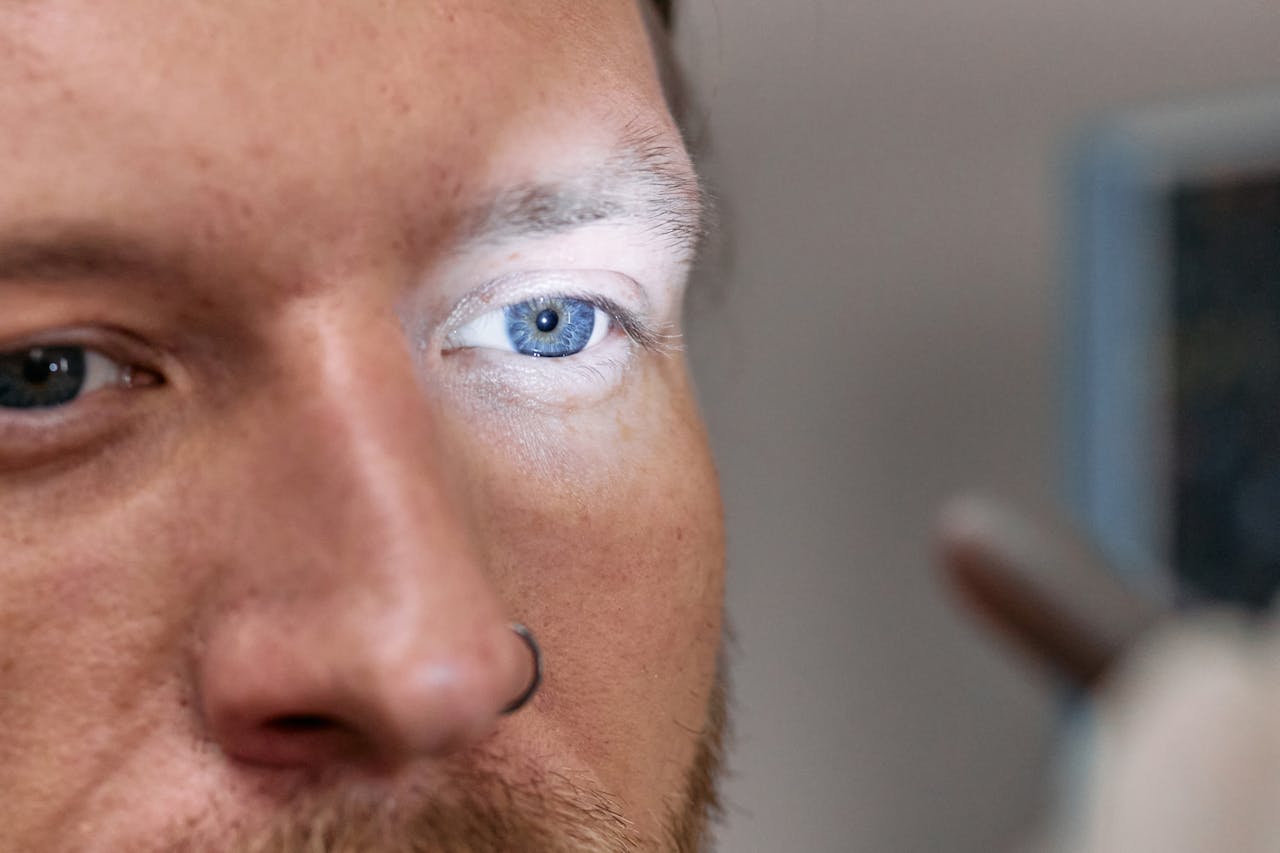
Left Upper Eye Twitch According to Javanese Primbon: Myths and Facts
The phenomenon of a twitch in the left upper eye often raises curiosity and concern for some people. In Javanese culture, this occurrence has its own meaning that has been passed down through generations via primbon. However, how accurate is the interpretation of Javanese primbon regarding eye twitches? Let’s delve deeper into the meaning of left upper eye twitch according to Javanese primbon, as well as the modern medical perspective on this phenomenon.
1. Understanding Eye Twitching in a Medical Context

Eye doctor (credit: pexels.com)
Before we discuss the interpretation of primbon, it is important to understand what is meant by eye twitching from a medical perspective. Eye twitching, or medically referred to as blepharospasm, is an uncontrolled muscle contraction of the eyelid. This phenomenon is generally not harmful and often lasts for a short duration.
Some characteristics of eye twitching include:
- Rapid and repetitive movements of the eyelid
- Usually occurs in one eye, but can also affect both eyes
- Duration varies, from a few seconds to several minutes
- Can occur sporadically or repeatedly over several days
Although it generally does not cause pain, eye twitching can disrupt daily activities and cause discomfort for those affected. Eye twitching is often a response of the body to various factors such as fatigue, stress, or nutritional imbalances.
2. Meaning of Upper Left Eye Twitching in Javanese Primbon
Javanese Primbon is a collection of traditional knowledge passed down through generations in Javanese society. One aspect discussed in the primbon is the interpretation of various bodily phenomena, including eye twitches. Here are some common interpretations regarding the meaning of upper left eye twitching according to Javanese primbon:
- A sign of receiving good news or joyful information
- A symbol of upcoming luck or unexpected fortune
- A signal of meeting someone you haven't seen in a long time
- A sign of experiencing an emotional or touching event
- A warning to be more cautious in making decisions
It is important to remember that these interpretations can vary depending on the timing of the twitch and other specific conditions. Some versions of the primbon even associate the meaning of twitches with the days and market days in the Javanese calendar. For example, a twitch occurring on a certain day may have a different meaning compared to other days.
While interesting, it is important to understand that these primbon interpretations do not have a scientific basis and are more a part of local wisdom and cultural tradition. Each individual is free to interpret this phenomenon according to their own beliefs and worldview.
3. Scientific Perspective on Eye Twitching
From a modern medical perspective, eye twitching is generally caused by various physiological and environmental factors. Some common causes include:
- Fatigue and lack of sleep
- Excessive stress and anxiety
- Excessive caffeine or alcohol consumption
- Eye irritation from dust or allergens
- Deficiency in certain nutrients, such as magnesium
- Prolonged use of electronic screens
- Side effects from certain medications
In the majority of cases, eye twitching is temporary and will resolve on its own. However, if it persists for a long time or is accompanied by other symptoms, it is advisable to consult a doctor to determine a more specific cause.
Eye health experts emphasize that eye twitching is not a direct indicator of a serious health condition. On the contrary, it is often a sign that the body needs rest or attention to a more balanced lifestyle.
4. Myths vs Facts: Unraveling Beliefs About Eye Twitches

Eye doctor (credit: pexels.com)
As medical knowledge advances, many myths surrounding eye twitches can be clarified. Here are some common myths along with their scientific facts:
Myth: Eye twitches always have a mystical or spiritual meaning.
Fact: Eye twitches are generally caused by physiological factors and can be explained scientifically.
Myth: Left and right eye twitches have different meanings.
Fact: Medically, there is no significant difference between left and right eye twitches.
Myth: Eye twitches are a sign of impending good luck.
Fact: There is no scientific evidence supporting a connection between eye twitches and luck.
Myth: Prolonged eye twitches indicate a serious problem.
Fact: Although prolonged twitches should be monitored, most cases are harmless.
Understanding the facts behind these myths is important to avoid unnecessary anxiety and to encourage a more rational approach to the phenomenon of eye twitches.
5. How to Deal with Eye Twitches
Although eye twitches are generally harmless, there are several steps that can be taken to reduce their frequency or intensity:
- Get enough quality rest
- Reduce caffeine and alcohol consumption
- Practice regular eye stretching and relaxation
- Ensure a balanced intake of nutrients, especially magnesium
- Apply the 20-20-20 rule when working with electronic screens (every 20 minutes, look at an object 20 feet away for 20 seconds)
- Use lubricating eye drops if your eyes feel dry
- Manage stress through relaxation techniques or meditation
If the twitching lasts more than a few weeks or is accompanied by other symptoms such as redness, swelling, or changes in vision, consult an eye doctor immediately.
6. Cultural Perspective: Eye Twitching in Various Cultures
Interestingly, interpretations of eye twitching are not only found in Javanese culture. Various cultures around the world have their own beliefs and interpretations regarding this phenomenon. Some examples include:
- Chinese Culture: Left eye twitching is considered a good omen, while right eye twitching is seen as less favorable.
- Indian Beliefs: Eye twitching is associated with various predictions, depending on which part of the eye twitches and the gender of the person.
- African Traditions: Some tribes in Africa believe that eye twitching is a message from ancestors or guardian spirits.
- European Folklore: In some European countries, eye twitching is linked to gossip or discussions about someone behind their back.
This diversity of interpretations shows that the phenomenon of eye twitching has long been a subject of attention and speculation in various cultures around the world. It reflects the human tendency to seek meaning in everyday physical experiences.
7. Eye Twitching in a Psychological Context

eye (credit: pexels.com)
In addition to medical and cultural perspectives, eye twitching can also be examined from a psychological viewpoint. Several aspects to consider include:
- Nocebo Effect: The belief that eye twitching has negative connotations can increase anxiety and stress, which ironically may worsen the twitching.
- Selective Attention: A person who is overly focused on eye twitching tends to experience it more frequently, even though the actual frequency does not change.
- Psychological Coping: For some individuals, believing in traditional interpretations can serve as a coping mechanism to deal with uncertainty or anxiety.
- Confirmation Bias: The tendency to remember events that align with traditional interpretations while ignoring those that do not.
Understanding these psychological aspects is important for addressing the phenomenon of eye twitching in a more wise and proportional manner. A balanced approach between scientific understanding and appreciation of cultural aspects can help individuals manage emotional reactions to the experience of eye twitching.
8. When Should You Worry About Eye Twitching?
Although most cases of eye twitching are harmless, there are some situations where this symptom requires medical attention. Here are some signs to watch out for:
- Twitching lasts for more than a few weeks without stopping
- Twitching is accompanied by weakness in the facial muscles or other parts of the body
- There are changes in vision or sensitivity to light
- The eyelids experience swelling, redness, or pain
- Twitching spreads to other parts of the face or body
- There is a decrease in the ability to open or close the eye
If you experience one or more of the above symptoms, consult an eye doctor or neurologist for further evaluation. A medical examination can help identify the underlying cause and determine the appropriate action.
9. The Role of Nutrition in Eye Health
One often overlooked factor in the context of eye twitching is the role of nutrition. A balanced nutrient intake is crucial for maintaining overall eye health, including reducing the risk of twitching. Some key nutrients for eye health include:
- Vitamin A: Essential for retinal function and vision in low light
- Vitamins C and E: Antioxidants that protect the eyes from free radical damage
- Omega-3: Supports retinal health and reduces the risk of dry eyes
- Lutein and Zeaxanthin: Protect the eyes from harmful blue light radiation
- Zinc: Plays a role in transporting vitamin A from the liver to the retina
- Magnesium: Helps muscle relaxation and may reduce twitching
Consuming nutrient-rich foods such as green vegetables, fatty fish, nuts, and colorful fruits can help maintain optimal eye health. Additionally, staying adequately hydrated is also important for overall eye health.
10. The Influence of Modern Lifestyle on Eye Health

Eye doctor (credit: pexels.com)
The digital era has brought significant changes to our lifestyle, including how we use our eyes. Several aspects of modern lifestyle that can affect eye health and increase the risk of eye strain include:
- Excessive gadget use: Staring at screens for long periods can cause eye fatigue
- Lack of outdoor activity: Reducing exposure to natural sunlight, which is important for eye health
- Irregular sleep patterns: Disruption of circadian rhythms can affect eye health
- Chronic stress: Increases muscle tension, including in the eye area
- Air pollution: Exposure to pollutants can cause irritation and eye fatigue
- Unbalanced diet: Deficiency in essential nutrients for eye health
Being aware of the impact of lifestyle on eye health can help us take preventive measures to reduce the risk of eye problems, including eye strain. It is important to create a balance between technology use and eye health care.
11. Eye Relaxation Techniques to Reduce Eye Twitches
In addition to lifestyle changes and nutritional intake, there are several eye relaxation techniques that can help reduce the frequency and intensity of twitches:
- Palming: Close your eyes with your palms without applying pressure, and hold for a few minutes to provide total darkness and relaxation
- Eye movements: Slowly move your eyes in different directions to stretch the eye muscles
- Near-far focus: Alternate focusing on distant and near objects to train the eye muscles
- Warm compress: Apply a warm compress to the eyes to relax the muscles and improve circulation
- Mindfulness meditation: Practicing mindfulness can help reduce stress and tension in the eye area
Regularly performing these techniques can help maintain eye health and reduce the risk of twitches. It is important to make eye care a part of your daily routine, especially for those who spend a lot of time in front of screens.
12. Conclusion
The phenomenon of the upper left eye twitching according to Javanese primbon is part of the cultural wealth and traditions that have long existed in society. Although primbon interpretations can provide spiritual or cultural meanings, it is important to understand this phenomenon also from a scientific and medical perspective.
Eye twitching is generally a harmless condition that can be explained through various physiological and environmental factors. However, if the twitching persists for a long time or is accompanied by other disturbing symptoms, it is advisable to consult a health professional.
In addressing the phenomenon of eye twitching, a balance is needed between appreciating cultural heritage and understanding scientific explanations. With a holistic approach, we can interpret the experience of eye twitching more wisely, while still maintaining eye health through a healthy lifestyle and proper care.
Finally, it is important to remember that each individual has unique experiences and interpretations of phenomena such as eye twitching. By combining scientific understanding, appreciation for local wisdom, and awareness of personal health needs, we can address eye twitching in the most beneficial way for ourselves.
(kpl/dhm)
Disclaimer: This translation from Bahasa Indonesia to English has been generated by Artificial Intelligence.

















